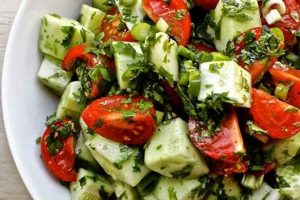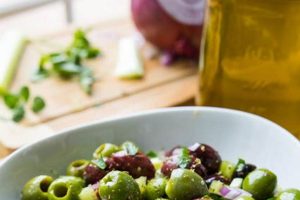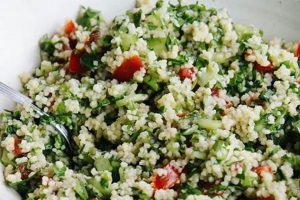A simple preparation of this classic dish typically involves cooked potatoes, combined with mayonnaise and a selection of other ingredients such as celery, onion, and mustard. Variations can include hard-boiled eggs, pickles, or relish. A basic version can be quickly assembled with readily available ingredients, offering a convenient side dish for picnics, barbecues, and potlucks.
Effortless versions of this dish are highly valued for their accessibility and convenience. Providing a satisfying and flavorful complement to a variety of main courses, these recipes are often passed down through families and adapted to individual preferences. The dish itself enjoys a rich history, with origins potentially traceable to European potato dishes that evolved with the introduction of mayonnaise. Its versatility allows for both simple and elaborate preparations, solidifying its position as a staple in many cuisines.
This exploration will further examine variations on simplified preparations, offering guidance on ingredient selection, preparation techniques, and serving suggestions. Considerations for dietary restrictions and creative adaptations will also be addressed.
Tips for Simplified Preparation
Achieving a delicious and effortless potato salad involves attention to key details throughout the preparation process. These tips offer guidance for optimizing flavor and texture.
Tip 1: Potato Selection and Cooking: Opt for waxy potatoes, such as red or Yukon Gold, as they hold their shape better after cooking. Avoid overcooking; potatoes should be tender but not mushy.
Tip 2: Efficient Cooling: Spread the cooked potatoes on a baking sheet to facilitate rapid and even cooling. This prevents them from becoming gummy and ensures a desirable texture in the final product.
Tip 3: Mayonnaise Management: Start with a smaller amount of mayonnaise and add more as needed to achieve the desired creaminess. This prevents an overly saturated salad.
Tip 4: Flavor Balancing: A balanced flavor profile is key. A touch of acidity from vinegar or lemon juice can brighten the overall taste. A hint of sweetness from a small amount of sugar or relish can also enhance the flavor complexity.
Tip 5: Ingredient Incorporation: Gentle folding prevents the potatoes from breaking down. Add delicate ingredients like hard-boiled eggs after the initial mixing of potatoes and mayonnaise.
Tip 6: Seasoning Strategies: Seasoning in stages allows for adjustments throughout the process. An initial seasoning of the potatoes while still warm allows for better absorption of flavor.
Tip 7: Chilling for Optimal Flavor: Allowing the salad to chill for at least an hour before serving allows the flavors to meld, resulting in a more cohesive and enjoyable dish.
By following these guidelines, one can achieve a flavorful and well-balanced potato salad with minimal effort. Careful attention to these details elevates a simple dish to a truly satisfying culinary experience.
These preparatory insights pave the way for exploring variations and adaptations in the following sections.
1. Waxy Potatoes
Waxy potatoes play a crucial role in achieving a successful easy potato salad recipe. Their lower starch content compared to starchy potatoes like russets results in a firmer texture that holds up well after cooking and mixing. This characteristic is essential for preventing the potatoes from breaking down and becoming mushy in the salad, maintaining a desirable textural contrast against the creamy mayonnaise and other ingredients. Using waxy potatoes ensures distinct potato pieces within the salad rather than a mashed potato-like consistency. This contributes to both visual appeal and palatable texture.
Choosing waxy potatoes, such as red-skinned potatoes, fingerlings, or Yukon Golds, offers distinct advantages in simplified preparations. These varieties require less attention during cooking, minimizing the risk of overcooking, a common pitfall that can lead to a gummy texture. Their ability to retain their shape also simplifies the mixing process, allowing for easier incorporation of other ingredients without damaging the potatoes. For example, a classic American-style potato salad benefits significantly from the use of red potatoes, which hold their shape well even after being mixed with a creamy dressing and other components like celery, onion, and hard-boiled eggs.
Understanding the importance of waxy potatoes in an easy potato salad recipe streamlines the cooking process and ensures a desirable outcome. Selecting these varieties minimizes potential textural issues, allowing for a simplified preparation while maintaining the integrity of the salad. This knowledge contributes to a more satisfying culinary experience, providing a firm, flavorful, and aesthetically pleasing potato salad with minimal effort. The practical application of this knowledge empowers cooks to achieve consistent results, eliminating the frustration of a mushy or disintegrated salad.
2. Efficient Cooling
Efficient cooling is a critical step in creating a successful easy potato salad recipe. It directly impacts the final texture and overall quality of the dish. Warm potatoes absorb mayonnaise differently than cooled potatoes, leading to a gummy or overly creamy consistency if not properly cooled. Furthermore, the heat from freshly cooked potatoes can accelerate bacterial growth, raising food safety concerns. Efficient cooling mitigates these risks and ensures a pleasant textural experience. For instance, spreading the freshly cooked, diced potatoes in a single layer on a baking sheet allows for rapid heat dissipation. This technique maximizes surface area exposure to cooler air, expediting the cooling process compared to leaving them piled in a bowl.
The practical significance of efficient cooling extends beyond texture and food safety. Properly cooled potatoes hold their shape better during mixing, preventing them from breaking down and creating a mushy salad. This is particularly important in easy recipes where minimal handling is desired. Additionally, cooling allows the potatoes to absorb flavors more effectively once the dressing and other ingredients are added. The cooled potatoes provide a neutral base for the other flavors to meld without being overpowered by residual heat. This can enhance the overall balance and complexity of the final dish. For example, if making a potato salad with a vinaigrette-based dressing, cooled potatoes will absorb the dressing more evenly, resulting in a more flavorful and balanced final product.
In summary, efficient cooling is not merely a time-saving measure but a crucial step that significantly impacts the texture, flavor, and food safety of an easy potato salad recipe. By understanding the science behind the process and employing techniques like spreading the potatoes on a baking sheet, one can ensure a desirable outcome with minimal effort. Overlooking this step can compromise the overall quality of the dish, undermining the goal of a simple yet delicious potato salad. This highlights the importance of considering each step in a recipe, even seemingly simple ones, for achieving optimal results.
3. Balanced Flavor Profile
A balanced flavor profile is paramount in a successful easy potato salad recipe. It distinguishes a bland, forgettable dish from a vibrant, enjoyable one. This balance hinges on the interplay of several key flavor components: saltiness, acidity, sweetness, and savoriness. The creamy richness of mayonnaise, a staple in most potato salads, necessitates a counterpoint. Acidity, typically from vinegar or lemon juice, cuts through the richness, providing a refreshing contrast. A touch of sweetness, often from a small amount of sugar or sweet pickle relish, further enhances complexity, balancing the tanginess of the acid. Salt enhances the overall flavor and ties the components together. An imbalance in any of these elements can result in a one-dimensional salad lacking depth and complexity. For example, a potato salad overly reliant on mayonnaise can feel heavy and cloying, while an excess of vinegar can make it overly sharp and acidic. A well-balanced potato salad, however, offers a harmonious blend of these flavors, each complementing the others to create a satisfying whole.
Achieving this balance in an easy recipe context requires careful consideration of ingredient choices and proportions. Pre-made dressings, while convenient, often lack the nuance and balance achievable with simple, fresh ingredients. Using a high-quality mayonnaise as a base, combined with measured additions of vinegar, sugar, salt, and other seasonings, allows for greater control over the final flavor profile. Fresh herbs, such as dill or chives, introduce a bright, herbaceous element, further enhancing complexity without complicating the preparation. For instance, a classic American-style potato salad often incorporates celery and onion for added texture and a subtle savory note, balancing the richness of the mayonnaise and the tang of yellow mustard. Such additions demonstrate how simple ingredients, judiciously used, contribute to a complex yet balanced flavor profile.
Understanding the interplay of these flavors empowers one to tailor the recipe to individual preferences. A preference for a tangier salad can be accommodated by increasing the amount of vinegar or incorporating a squeeze of lemon. Conversely, a milder flavor profile can be achieved by reducing the acidity and increasing the sweetness. The practical application of these principles allows for customization without sacrificing the fundamental balance necessary for a delicious and easy potato salad. This adaptability highlights the importance of a balanced flavor profile, not as a rigid formula, but as a dynamic interplay of tastes that can be adjusted to create a personalized culinary experience.
4. Minimal Mayonnaise
Minimal mayonnaise plays a crucial role in achieving a successful easy potato salad recipe. While mayonnaise contributes creaminess and binds the ingredients, an excessive amount can result in a heavy, cloying texture that overshadows the other flavors. A lighter touch allows the natural flavors of the potatoes and other ingredients to shine through. This is particularly important in easy recipes where the focus is on simplicity and fresh ingredients. Furthermore, using less mayonnaise reduces the overall richness of the salad, making it a more refreshing side dish, especially in warmer weather. For example, a potato salad made with a modest amount of mayonnaise, complemented by a vinaigrette dressing, offers a lighter, brighter flavor profile compared to one saturated with mayonnaise.
The practical implications of using minimal mayonnaise extend beyond flavor and texture. It simplifies the preparation process, reducing the need for constant adjustments to achieve the desired consistency. A lighter hand with mayonnaise also makes it easier to incorporate other ingredients without the salad becoming overly dense or difficult to mix. This is particularly advantageous in easy recipes where minimal handling is desired. From a nutritional standpoint, using less mayonnaise reduces the overall fat and calorie content, aligning with healthier eating preferences without sacrificing flavor. For instance, incorporating fresh herbs and a squeeze of lemon juice can enhance the flavor profile while keeping the salad light and refreshing.
In summary, minimal mayonnaise is a key element in a successful easy potato salad recipe. It contributes to a lighter, brighter flavor profile, simplifies the preparation process, and aligns with healthier eating habits. Understanding the role of mayonnaise and its impact on the final product allows for greater control over the outcome, ensuring a balanced and enjoyable dish with minimal effort. This approach highlights the importance of ingredient proportion in achieving a simple yet satisfying culinary experience.
5. Gentle Mixing
Gentle mixing is a crucial technique in easy potato salad recipes. Forceful mixing can damage the cooked potatoes, resulting in a mushy, unappetizing texture. Maintaining the structural integrity of the potato pieces is essential for both visual appeal and palatable texture. A light touch ensures the potatoes remain intact, absorbing the dressing and other ingredients without breaking down. This is particularly important when using waxy potatoes, which, despite their firm texture, can still be crushed with excessive force. For example, when combining the cooked potatoes with mayonnaise and other ingredients, a folding motion using a spatula or large spoon is preferable to vigorous stirring. This gentle approach preserves the shape of the potatoes and distributes the dressing evenly without crushing them.
The practical significance of gentle mixing extends beyond aesthetics. Intact potato pieces offer a more enjoyable eating experience, providing a satisfying textural contrast against the creamy dressing and other ingredients. Overly mashed potatoes, conversely, create a heavy, dense consistency that can detract from the overall enjoyment of the salad. Moreover, gentle mixing promotes even distribution of flavors. The dressing and seasonings coat the potato pieces uniformly, ensuring each bite delivers a balanced flavor profile. Conversely, aggressive mixing can create pockets of concentrated dressing and leave other areas under-seasoned. This uneven distribution can compromise the overall flavor experience. Consider a potato salad with delicate herbs and spices; gentle mixing ensures these delicate flavors are distributed evenly throughout the salad without being crushed or bruised.
In summary, gentle mixing is a seemingly minor detail with significant implications for the texture and flavor of easy potato salad recipes. This technique preserves the structural integrity of the potatoes, contributing to a more appealing presentation and a more enjoyable eating experience. It also ensures even flavor distribution, maximizing the impact of the seasonings and other ingredients. Mastering this technique, though simple, is essential for achieving a high-quality potato salad with minimal effort. This attention to detail, often overlooked, distinguishes a truly exceptional potato salad from a mediocre one.
6. Adequate Chilling Time
Adequate chilling time is a crucial element often overlooked in easy potato salad recipes. While seemingly a passive step, it significantly impacts the final flavor and overall quality of the dish. Chilling allows the flavors of the various ingredientspotatoes, mayonnaise, seasonings, and additionsto meld and harmonize, creating a more cohesive and complex flavor profile. This chilling period also allows the potatoes to further absorb the dressing, enhancing their flavor and improving the overall texture of the salad.
- Flavor Development
Chilling allows the diverse flavors within the potato salad to meld and mature. The initially distinct tastes of the individual componentstangy vinegar, creamy mayonnaise, savory mustard, and the earthy potatoesgradually integrate, creating a more unified and nuanced flavor profile. This fusion of flavors is essential for a well-rounded and satisfying potato salad experience. For example, the sharpness of the vinegar mellows, blending harmoniously with the richness of the mayonnaise, while the potatoes absorb these flavors, becoming infused with a balanced complexity.
- Texture Enhancement
Chilling firms the potatoes, enhancing their textural appeal. The cooling process allows the starches in the potatoes to set, resulting in a firmer, less mushy consistency. This is particularly important in potato salads dressed with mayonnaise, as the chilling process helps prevent the potatoes from becoming overly saturated and losing their structural integrity. This improved texture contributes to a more pleasant mouthfeel and prevents the salad from becoming overly creamy or dense. A chilled potato salad offers a more distinct textural contrast between the firm potatoes and the creamy dressing.
- Food Safety
Chilling is essential for food safety, particularly in mayonnaise-based salads. Potato salad, like other dishes containing mayonnaise, is susceptible to bacterial growth if left at room temperature for extended periods. Adequate chilling inhibits bacterial proliferation, minimizing the risk of foodborne illnesses. Adhering to safe food handling practices, such as refrigerating the potato salad promptly after preparation and maintaining it at a safe temperature, is crucial for preventing spoilage and ensuring the dish remains safe for consumption.
- Enhanced Serving Temperature
The chilled temperature of the potato salad enhances its refreshing quality, making it particularly appealing in warmer weather. A cool, creamy potato salad provides a welcome contrast to hot main courses, offering a palate-cleansing element to the meal. Serving potato salad chilled enhances the perception of its flavors, making the tanginess of the vinegar and the richness of the mayonnaise more pronounced and enjoyable. This is especially relevant for outdoor gatherings and picnics where temperature control is crucial for both enjoyment and food safety.
In conclusion, adequate chilling time is not merely a final step but an integral part of crafting a successful easy potato salad recipe. It plays a crucial role in flavor development, texture enhancement, food safety, and overall enjoyment. Understanding the importance of this seemingly passive step elevates the simple potato salad from a basic side dish to a more refined and satisfying culinary experience. Neglecting this crucial step compromises the overall quality and enjoyment of the dish, highlighting the importance of considering every detail, even the timing, in a recipe.
7. Simple Seasonings
Simple seasonings are fundamental to a successful easy potato salad recipe. Their judicious use enhances the natural flavors of the potatoes and other ingredients without overwhelming the palate. Overly complex or intense seasonings can mask the subtle nuances of a well-made potato salad, particularly one emphasizing fresh, high-quality ingredients. Classic seasonings like salt, black pepper, and paprika offer a balanced foundation, allowing the inherent flavors of the potatoes, mayonnaise, and other components to shine. For example, freshly ground black pepper provides a subtle warmth and complexity that complements the creamy dressing and the earthy potatoes without overpowering them. This approach aligns with the “easy recipe” concept, focusing on readily available ingredients and minimizing preparation complexity.
The effectiveness of simple seasonings in easy potato salad recipes stems from their ability to enhance rather than dominate. Fresh herbs, such as dill, chives, or parsley, provide a bright, herbaceous note that complements the other flavors without introducing unnecessary complexity. Similarly, a touch of celery seed or onion powder can add depth and complexity without requiring extensive preparation. The choice of seasonings can also be tailored to complement specific variations. For instance, a German-style potato salad might benefit from the addition of a pinch of caraway seeds, while a more traditional American-style potato salad often incorporates sweet pickle relish for a touch of sweetness and tang. These examples demonstrate how simple seasonings, carefully chosen, can elevate a basic potato salad to a more flavorful and nuanced dish without demanding extensive culinary expertise or preparation time.
Understanding the role of simple seasonings in easy potato salad recipes is crucial for achieving a balanced and flavorful dish with minimal effort. The focus should remain on enhancing the natural flavors of the core ingredients rather than masking them with overpowering spices or complex flavor combinations. This principle underscores the essence of an “easy recipe”simplicity without sacrificing flavor. By judiciously selecting and applying simple seasonings, one can create a potato salad that is both easy to prepare and satisfying to consume, showcasing the inherent deliciousness of fresh ingredients without unnecessary complexity. This approach emphasizes the importance of restraint and balance in achieving culinary excellence, even in seemingly simple dishes.
Frequently Asked Questions
This section addresses common inquiries regarding simplified potato salad preparation.
Question 1: What type of potato is best suited for a simple potato salad?
Waxy potatoes, such as red or Yukon Gold, are ideal due to their firm texture, which holds up well during mixing and prevents a mushy salad.
Question 2: How can one prevent the potatoes from becoming gummy?
Ensure thorough and rapid cooling after cooking. Spreading the cooked potatoes on a baking sheet facilitates quicker cooling than leaving them in a bowl.
Question 3: What is the key to a well-balanced flavor profile?
Balancing the richness of mayonnaise with acidity (vinegar or lemon juice), a touch of sweetness, and appropriate seasoning is crucial for a flavorful, non-cloying salad.
Question 4: How much mayonnaise should be used?
A lighter hand with mayonnaise is generally preferred in simpler recipes. Start with a smaller amount and add more as needed, prioritizing a balanced flavor and texture over excessive richness.
Question 5: What is the best way to incorporate the ingredients?
Gentle folding prevents the potatoes from breaking down. Delicate ingredients like hard-boiled eggs should be added after the initial mixing of potatoes and mayonnaise.
Question 6: How long should the potato salad be chilled before serving?
Chilling for at least one hour allows the flavors to meld and the potatoes to absorb the dressing thoroughly. Longer chilling times can further enhance flavor development.
Careful attention to these details ensures a successful outcome when preparing a simplified potato salad.
The following section will offer variations and recipe adaptations.
Potato Salad Easy Recipe
This exploration of simplified potato salad recipes has highlighted the essential elements contributing to a successful outcome. From the selection of waxy potatoes and the importance of efficient cooling to the delicate balance of flavors and the judicious use of mayonnaise, each step plays a vital role in the final product. Gentle mixing techniques preserve the integrity of the potatoes, while adequate chilling time allows the flavors to meld and mature. The strategic use of simple seasonings enhances the natural flavors of the ingredients without overwhelming the palate. Attention to these key details ensures a potato salad that is not only easy to prepare but also delivers a satisfying culinary experience.
Ultimately, a well-executed potato salad, even in its simplest form, exemplifies the power of culinary fundamentals. Understanding the underlying principles of ingredient selection, preparation techniques, and flavor balancing elevates this classic dish from a simple side to a culinary achievement. This knowledge empowers cooks of all skill levels to create a delicious and memorable potato salad with minimal effort, demonstrating that culinary excellence is attainable through a combination of understanding and careful execution.






